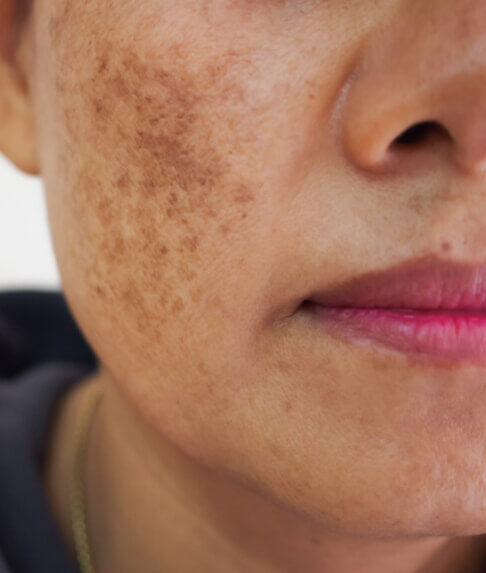
Today, a wide spectrum of skin tones can be found in all parts of the world. Melanin is the pigment that gives color to the skin. The darkening of the skin that occurs after exposure to the sun is actually part of the skin’s natural protection process from sun damage. Changes in skin tones can also be caused by hormonal changes due to increased melanin production.
Usually, increased pigmentation is temporary. It fades over time, and the skin returns to its natural shade. Over time, some darkening of skin tone can become persistent. Long-lasting uneven skin tone – dark patches on the face, limbs, and other body areas – may be a sign of melasma.
Melasma is a skin condition characterized by symmetrical patches of dark discoloration of the skin. What this means is that these patches will often appear in a similar pattern on both sides of the body. For example, they could appear on both cheeks. Melasma is an overabundance of pigmentation.
Melasma is more common among women than men, and it usually affects young women more frequently than older women. Pregnant women can experience melasma during pregnancy as a result of hormonal changes. This is sometimes called “the mask of pregnancy.”
How is Melasma Identified or Diagnosed?
Melasma is one form of hyperpigmentation, and it may sometimes share an appearance similar to other forms of the condition. For example, post-inflammatory hyperpigmentation (PIH) is a form of hyperpigmentation that results from inflammation or trauma to the skin. However, melasma is more likely to affect the forehead, cheeks, nose, chin, and lips. Other sun-exposed areas, like forearms and neck, also can be involved.
Melasma is often identified by its characteristic symmetric distribution and patchy appearance.
A doctor, such as a dermatologist who specializes in skin conditions, can identify melasma based on a visual examination. The characteristic appearance of melasma is usually enough to determine a diagnosis, though the doctor will likely ask questions about when and how the condition began. Since melasma may be inherited and runs in families, the doctor may also ask about family members who may have similar skin concerns.
If needed, there are a few tests that can help support the diagnosis of melasma. A Wood’s Lamp is a special light that, when shined on the skin, can make it easier for a doctor to see the variation in skin pigmentation. A biopsy – a tiny sample of skin that the doctor removes – can be tested to confirm melasma.
What Causes Melasma?
As a natural defense mechanism, the skin revs up production of melanin through a complex process that involves numerous different types of cells in the skin. These may include hormones and immune cells, among others. The process begins when the skin receives a signal of potential damage and usually lasts for a brief period. Melasma develops when this natural process is too robust or does not turn off.
Multiple factors can contribute to melasma. For example:
- There can be genetic contributors, meaning that a predisposition to melasma may be inherited. Many people with melasma report that a parent or other family member had the condition, too.
- Hormonal factors can affect melasma. Melasma may indicate underlying hormonal imbalances or result from hormonal changes related to pregnancy. Certain birth control pills have been linked to melasma because of their influence on hormones.
- Sun exposure – especially over a significant amount of time – can lead to hyperpigmentation.
- High heat exposure and stress have been linked to melasma to some degree.
Is Melasma Dangerous?
Melasma is not dangerous. Remember, it is a result of the skin’s natural defense mechanisms. However, patchy pigmentation may be a cosmetic concern. When melasma appears on the face, it can cause distress for the affected individual. Individuals may also become frustrated about the persistence of the condition. Stress over the appearance of melasma can, unfortunately, further aggravate the condition.
People with melasma also may report low self-confidence and, in some cases, individuals say that the condition contributes to feelings of depression.
Melasma in Brief
Melasma is a form of hyperpigmentation. The skin condition is characterized by patches of dark discoloration of the skin that tends to be symmetrical (usually appearing on both sides of the body in a similar pattern). Sun exposure and hormones are the main contributors to melasma.
Did You Know?
Melanin doesn’t just determine skin color. The color of hair and even the eyes is determined by melanin. Melanocytes are the cells that produce melanin in the body naturally.
Melasma Fast Fact
Melasma affects women more often than men. In fact, the Skin of Color Society reports that 90% of people with melasma are women.
Resource:
https://www.aad.org/public/diseases/a-z/melasma-treatment

